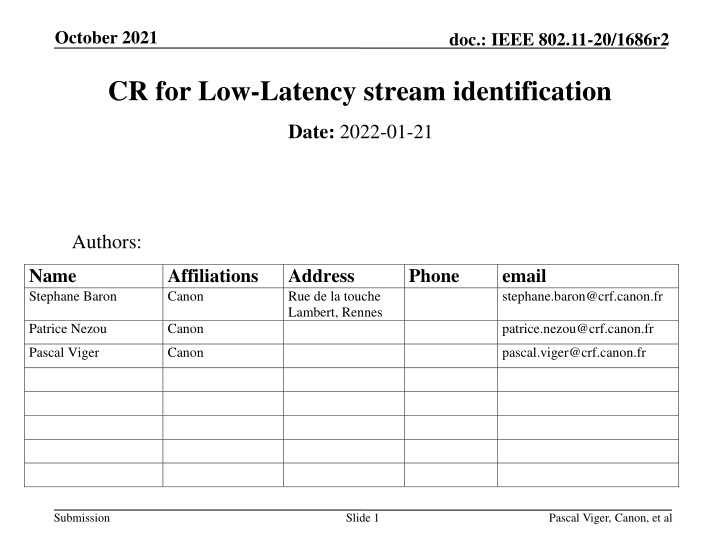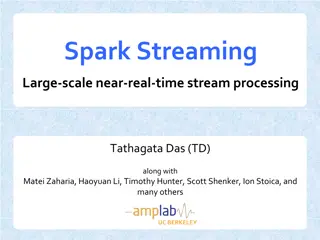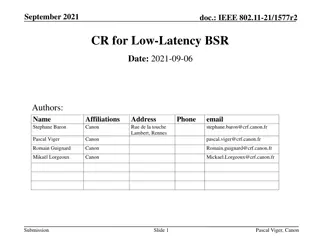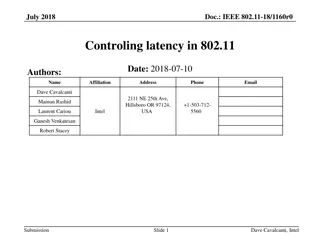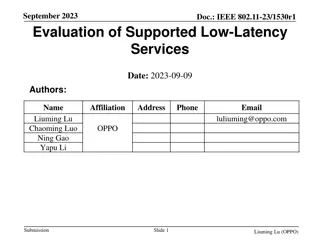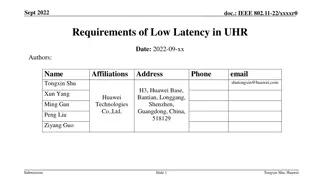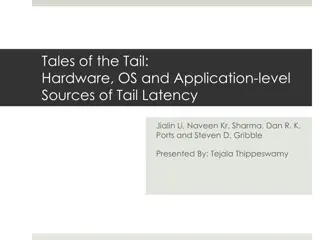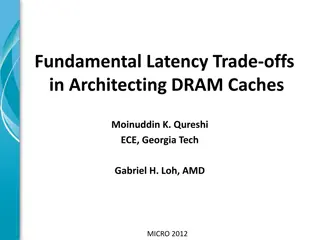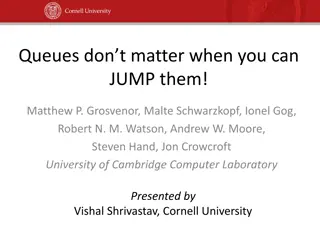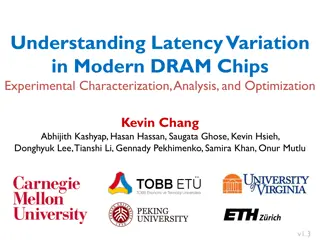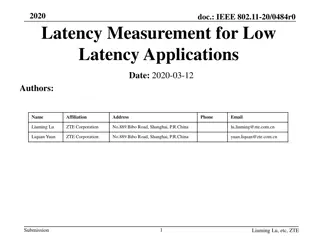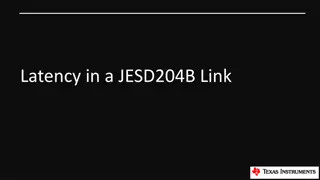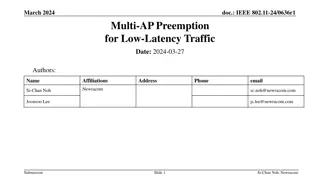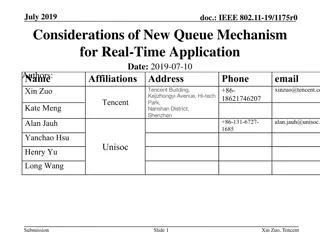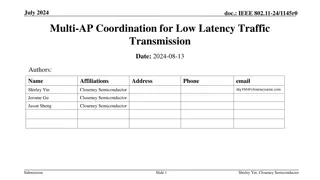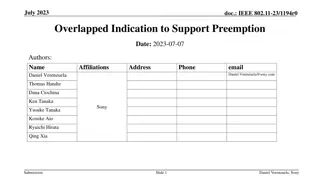CR for Low-Latency stream identification
In this contribution, the document discusses the identification and discrimination of latency-sensitive traffic for efficient transportation over IEEE 802.11be using resource reservation mechanisms such as rTWT. It addresses inconsistencies in the differentiation of latency-sensitive streams and non-latency-sensitive streams on the same STA, focusing on fair medium access and optimal scheduling. The document also explores related CIDs and proposes changes to enhance the management and conveyance of low-latency data. Key elements considered include Buffer Status Reports (BSR) for indicating data availability in STA queues.
Download Presentation

Please find below an Image/Link to download the presentation.
The content on the website is provided AS IS for your information and personal use only. It may not be sold, licensed, or shared on other websites without obtaining consent from the author.If you encounter any issues during the download, it is possible that the publisher has removed the file from their server.
You are allowed to download the files provided on this website for personal or commercial use, subject to the condition that they are used lawfully. All files are the property of their respective owners.
The content on the website is provided AS IS for your information and personal use only. It may not be sold, licensed, or shared on other websites without obtaining consent from the author.
E N D
Presentation Transcript
October 2021 doc.: IEEE 802.11-20/1686r2 CR for Low-Latency stream identification Date: 2022-01-21 Authors: Name Stephane Baron Affiliations Canon Address Rue de la touche Lambert, Rennes Phone email stephane.baron@crf.canon.fr Patrice Nezou Canon patrice.nezou@crf.canon.fr Pascal Viger Canon pascal.viger@crf.canon.fr Submission Slide 1 Pascal Viger, Canon, et al
October 2021 doc.: IEEE 802.11-20/1686r2 Abstract In this contribution, we discuss about how to identify and discriminate latency sensitive traffics, in order to be efficiently transported over 802.11be resource reservation mechanisms (e.g. rTWT). Submission Slide 2 Pascal Viger, Canon, et al
October 2021 doc.: IEEE 802.11-20/1686r2 Motivation Section 35.7.2.1 Latency sensitive traffic differentiation of 802.11be D1.1 is empty There are inconsistencies in 802.11be D1.1 : - Restricted TWT DL/UL TID Bitmaps (9.4.2.199 TWT element) specify TID(s) identified as latency-sensitive streams - SCS has been recently re-introduced along with modified TSPEC specification and TCLAS classification, providing a fine identification of latency-sensitive streams. =>It seems that a traffic specification is provided (SCS), but no medium access means is setup for accurate transportation Issue not yet addressed: There could have several LL streams on a STA, but also non-LL streams that share same TID/AC as LL streams. Non-LL streams shall not take advantage of medium access offered to LL streams., otherwise unfair ! LL stream: Low-Latency, aka. Latency Sensitive, stream/traffic Submission Slide 3 Pascal Viger, Canon, et al
October 2021 doc.: IEEE 802.11-20/1686r2 Related CIDs Clause Number 35.6.2.1 CID Commenter Comment Proposed Change 6511 Pascal VIGER "Latency sensitive traffic differentiation" is not clear enough. as in comment. Please consider fairness by differenciating transportation of LS and non-LS traffic of a same TID As nowadays a end-device is multiple content producer, there shall exist a diferenciation of latency sensitive and not-latency-sensitive traffics (e.g. from local application) belonging to a same TID. Assigned: Duncan Ho Otherwise, considering all traffics belonging TID as identical transportation is unfair ! There is plan to add TSPEC based signaling to provide parameters that describe traffic characteristics within the SCS procedure, especially the low latency (LL) parameters, so that AP shall be able to create an optimal schedule. 6521 Pascal 35.4.2 The LL data shall be managed by SCSID identifier for the communications, that is to say the SCSID is used to discriminate LL data inside a TID and that have to be handled by LL medium access mechanisms: e.g. MU triggering, rTWT use. VIGER Assigned: Duncan Ho In order to meet those Low latency requirements, the AP shall be able to finely (or let us say only) trigger the LL data, and not all the pending data of same traffic class or TID (because the remaining traffic remaining in the TID are not-LL sensitive and shall not be conveyed with same means like rTWT). In complement, the LL data shall be conveyed over multiple links, independently of remaining not-LL traffic. Submission Slide 4 Pascal Viger, Canon, et al
October 2021 doc.: IEEE 802.11-20/1686r2 Discussion 3 main elements have to be considered for latency-sensitive stream: Buffer status report (BSR) is used to indicate to the AP the amount of data the STA has available in its queues for transmission. BSRs takes the form of QoS-Control with Queue Size, or BSR-Control BSR can be solicited by a TF Trigger Frame is used by AP to control medium access and trigger a specific stream Restricted-TWT (rTWT) : UL/DL TID bitmap are under consideration Current issues: BSR: BSRs work at AC level (Queue Size subfield, Queue Size All subfield) Trigger frame : Today, only Preferred AC may be identified rTWT: Problem is that a TID can also contain non latency sensitive (non-LL) data, thus it is unfair to transport those non-LL data as well as highest-priority LL data. Submission Slide 5 Pascal Viger, Canon, et al
October 2021 doc.: IEEE 802.11-20/1686r2 Proposal An LL stream is individually specified by a Qos_Characteristics IE within an SCS Descriptor. It is therefore required to consider both TID and SCSID to qualify the stream in both BSRs and TFs for efficient UL MU operation : - SCSID-based low latency traffic differentiation mechanism, to be used by high-end STAs able to finely separate low latency data against normal data, - TID-based low latency traffic differentiation, for other STAs. Submission Slide 6 Pascal Viger, Canon, et al
October 2021 doc.: IEEE 802.11-20/1686r2 Related discussions and comments, since last presentation Implementations drive the identification mode of low latency traffic: Some implementations can handle extra queues (> 8 TIDs) : SCSID-based identification (fairest) Other implementations rely only on 8 TIDs (note possibly multiple flows are combined in a TID) : Case 1: SN assignment performed on MAC arrival (no intra-TID prioritization is possible, Head-of-line blocking exists) : TID-based identification, as a sort of best-effort LL traffic prioritization Case 2: SN assignment performed upon transmission (intra-TID/per-SCS prioritization is performed prior SN, without HOL issue) : both TID-based or SCSID-based identifications can be used (of course later is more explicit and efficient, especially when 2 SCS belong to same TID class) Concept of prioritization is now adopted for LL traffic delivery (21-1802r9) 37.7.5 Traffic delivery : In a trigger-enabled restricted TWT SP, when scheduling the transmission of Trigger frames, the r-TWT scheduling AP shall first trigger member r-TWT scheduled STAs to facilitate them to first deliver their QoS Data frames of r-TWT UL TID(s), if any. TID-based implementations: As each r-TWT scheduled STA selects a TID by its own, there is chance that all TIDs become r-TWT TIDs (that means all TIDs are listed in r-TWT IE for Broadcast TWT, and STA doesn t know which considered)*. Therefore r-TWT scheduled STA must know which TID is requested with regards to itself SCSID-based implementations : Support of SCSID in rTWT and TF As each r-TWT scheduled STAs selects an SCSID value by its own (generally starting from 0), SCSID shall be triggered with regards to a specific STA (in TF and r-TWT IE). Submission Slide 7 Pascal Viger, Canon, et al
October 2021 doc.: IEEE 802.11-20/1686r2 Example formats to support TID and SCSID Trigger Frame is updated to trigger an SCS stream (through TID/SCSID): Applicable only to EHT STAs, Trigger Dependent User Info Format compatible with HE format B5 set to 1 indicates new EHT Trigger Dependent User Info field variant B2 (Trigger Dependent Type subfield) identifies the encoding of the EHT Trigger Dependent User Info field variant: Value 0: SCSID/TID subfields (part 1 and part 2) represent a TID value Value 1: SCSID/TID subfields (part 1 and part 2) represent an SCSID value B2 B0 B1 B6 B7 B5 B3 B4 MPDU MU Spacing factor 2 Presence of EHT format 1 Trigger Dependent Type 1 SCSID/TID part 1 SCSID/TID part 2 2 Bits: 2 802.11ax format when B5 is Reserved (value 0) 802.11be format when B5 takes value 1 Submission Slide 8 Pascal Viger, Canon, et al
October 2021 doc.: IEEE 802.11-20/1686r2 TWT IE can be adapted to identify precisely SCS stream per STA: Applicable only to EHT STAs, In order to provide precise identification of low latency streams per station in Broadcast TWT SP, individual identifications (either TID/SCSID-based) are supported per each scheduled STA Individual ID Info is mutually exclusive against TID bitmaps Possible location may be inside Restricted TWT Traffic Info field Figure 9-689c Traffic Info Control field format B0 DL TID Bitmap Valid 1 B1 UL TID Bitmap Valid 1 B2 Individu al ID Valid 1 B3 B7 Reserved Nominal Minimum TWT Wake Duration 1 Target Wake Time 2 TWT Wake Interval Mantissa 2 Restricted TWT Traffic Info Request Type Broadcast TWT Info Bits: 5 0 or 3 1 2 Octets: Restricted TWT DL TID Bitmap 1 Restricted TWT UL TID Bitmap Traffic Info Control Individual ID Info B0 B11 B13 B15 B16 B31 Reserv ed Type B12 1 variable 1 Octets: SCSID / TID AID12 Bits: 12 1 3 TBD if 4 enough? Number of SCSID tuples 1 ID tuple #1 2 Variable Octets: Figure 9-689b Restricted TWT Traffic Info field format Submission Slide 9 Pascal Viger, Canon, et al
October 2021 doc.: IEEE 802.11-20/1686r2 Summary This contribution discussed about similar identification of latency sensitive streams, in TF and rTWT: both TID-based and SCSID-based. Use of SCSID may be preferred by high-end STAs, because it is: More efficient, as SCSID finely identifies streams at AP and STA sides Transparent to HE devices, Fair, as only the identified LL stream is triggered (no other data in TID/AC queue takes advantage of this medium access) Use of TID (instead of AC) is still possible: Simple, even less efficient than SCSID, for STAs not able to finely discriminate LL streams, Finer granularity, (e.g. in TF or BSR) as one AC contains 2 TIDs, Transparent to HE devices. Submission Slide 10 Pascal Viger, Canon, et al
October 2021 doc.: IEEE 802.11-20/1686r2 Straw Poll #1 Do you support that 802.11be makes use of both TID and SCSID as individual identification inside TFs and rTWT elements for latency-sensitive traffics ? Note: result of the strawpoll aims to trigger the resolution of CIDs 6511/6521 Results: Y/N/A Submission Slide 11 Pascal Viger, Canon, et al
October 2021 doc.: IEEE 802.11-20/1686r2 Straw Poll #2 Do you support that 802.11be support individual identification (stream identifier per r-TWT scheduled STA) inside rTWT elements for latency-sensitive traffics ? Results: Y/N/A Submission Slide 12 Pascal Viger, Canon, et al
October 2021 doc.: IEEE 802.11-20/1686r2 Reference [1]. Draft P802.11be_D1.1 [2]. CR for Low Latency BSR: https://mentor.ieee.org/802.11/dcn/21/11-21-1577-00-00be- cr-for-low-latency-bsr.pptx Submission Slide 13 Pascal Viger, Canon, et al
